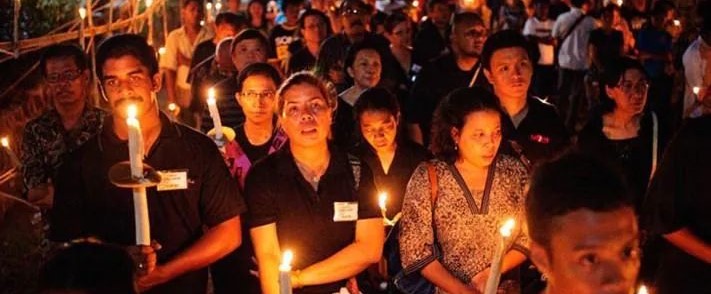
The old Catholics of Larantuka
by Simeone Andrulli
As Flores lays on the trading route to Timor (sandalwood) and the Moluccas (spices), Portuguese chroniclers also noted the existence of the island in 16th century. Dominican missionaries built a stone fort and a church on Solor, a small island in front of Larantuka, eastern Flores, in 1561. So enthusiastic were the Dominican friars in their proselytizing that by 1599 there were thought to be 100,000 Roman Catholics in Flores.
In 1613 the Dutch ship 'Half Moon', anchored off Solor and bombarded the Portuguese fort, forcing the 1,000 strong population to surrender. Two of the Dominican friars - Caspar de Spiritu Santo and Augustino de Magdalena - asked that rather than withdraw to Melaka (Malaysia) with the rest of the population, to be landed at Larantuka. Here they set about building another mission and by 1618 they established more than 20 missions in the area. However as the Portuguese lost influence so the Roman Catholics of Larantuka became isolated. The raja of the area took the title "Servant of the Queen of the Rosary" and the church's devotional objects - chalice, cross, statue and so on - became part of the local adat (tradition). Christianity became fossilized: the few Dutch Protestant ministers were sent smartly packing when unsatisfactorily answered questions about Mary, mother of Jesus and visits by Portuguese Roman Catholic priests were few and far between.
Even so the Roman Catholic rites and beliefs inculcated by the original Dominican friars were handed down through generations. Devotees were taught say their prayers in Latin and old Portuguese and to wear robes like those of 17th century 'penitentes' with pointed hood. When the Roman Catholics of Larantuka were finally 're-discovered' by the Dutch priest, Father C. de Hesselle in 1853 he was amazed to see the population keeping to a tradition over two centuries old.
The small town of Larantuka is the district capital of East Flores with a population of 25,000. It is still strongly Christian with a remarkable Easter celebration showing Portuguese origin and a parade replete with a rudely-hewn cross carried in procession. Moreover particular devotion is shown to the Virgin Mary, a statue of whom was reportedly miraculously wash-up on the shore here. The Chapel of the Virgin Mary, in the center of the town, houses the sacred statue of the Virgin. On early Saturday mornings, women from the town gather in the Chapel of the Virgin Mary and say their prayer - the Mama Muji pray - in ancient Latin and Portuguese, distorted to such a degree that it is intelligible even to students of the language. This tradition has incredibly remained untouched in the last three centuries and an half. Men on the other hand were supposed to recite the Rosary privately. This was interpreted as a duty especially for members of the 'Confreria Rainha Rosarii' (Brotherhood of the Rosary Queen) but suspicion arose that some members were not devoted to duty thus for the last 12 years the 'Confreria' members meet regularly soon after the women have finished their prayer integrating in thenlocal tradition as well.
Being part of a largely Muslim nation like Indonesia seems quite a more serious threat than centuries of isolation. Due to the resettlement scheme implemented by Jakarta government - Transmigrasi - Muslims from Java and Sumatra have installed in Larantuka like elsewhere in the archipelago. On 11 June '95 a Javanese, officially visiting a friend, attended the mass at the local church disconcerting the presents , he crumbled it in front of the priest, instead ofswallowing the Host. Interpreted as blasphemous and intentionally provocative the Larantukans demanded his head who had taken refuge in the church. Inter-religious clashes flared up, the shops owned by Muslims were burnt and the Javanese got killed.
Author & Designer: Simeone Andrulli
tymbaryon@gmail.com
© Tymbaryon
